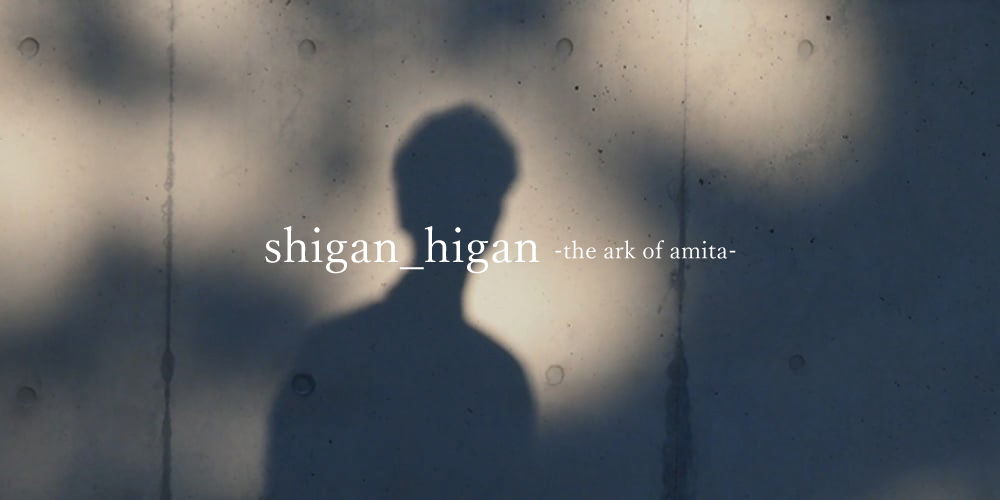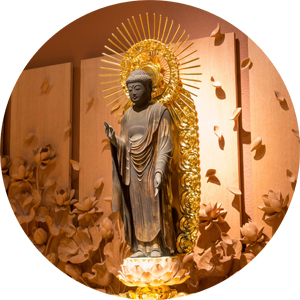Ⅰ04.Light from the other shore
Japan has national holidays that are determined each year based on astronomy, which is said to be rare even on a global scale. These are the days that occur twice a year, in spring and autumn, when the length of day and night are equal: the vernal equinox and the autumnal equinox.
No matter where you are on Earth, the sun rises in the east and sets in the west. However, the positions of sunrise and sunset shift slightly each day and complete a yearly cycle. On the spring and autumn equinoxes, the sun rises due east and sets due west.
In Japan, this day is known as the “Higan no chunichi (middle day of the equinox,”) and the week consisting of the three days before and after this day is familiarly known as “Higan (equinoctial week).” “Higan” is a period of seasonal change that occurs twice a year. Since ancient times, Japanese people have cherished these periods, calling them “haru-higan” for spring and “aki-higan” for autumn.
The word “Higan” has a Buddhist meaning. The ancient Indian Sanskrit word “PARAMITA” was transmitted to China and translated as “tou-higan.”
Tou-higan, originally paramita, means “to reach the other shore.” This word contains the meaning of completing one’s training and reaching nirvana, the state of enlightenment. This state of nirvana is likened to a place and is expressed as higan, that is, the other shore.
It is the place where a Buddha who has attained enlightenment resides. The Mahayana Buddhism scriptures tell a mythical story about a Buddhist paradise called the “Jodo (Pure Land)” to the west.
In other words, “Jodo” is “Higan” on the other side to the west. The opposite word to Higan is “Shigan.” It means “this shore,” referring to the world we live in here and now. While Jodo means “an extremely comfortable and pure place,” this shore is referred to as “Saha.” The word “Saha” means “a troublesome place full of suffering and worries.”
When viewed from this world, no matter how wonderful a place may be, it seems so far away that we can never reach it. In order to attain that world, one must completely get rid of the earthly desires that are the cause of human suffering and worries. The world of enlightenment is not so easily attained.
Before that, because we are unaware of any possibilities other than living in the world of earthly desires, we cannot even realize that such a world exists. Is it because there is so much distance between Shigan and Higan?
During the winter we say, “It’s too cold. I wish it would warm up soon,” and during the summer we say, “It’s too hot. I wish it would cool down soon,” and we spend our days complaining about things that there’s no point in complaining about. In our daily lives, we do not even try to face the other shore, but simply live our busy lives here on this shore.
Jodo, or Higan, is said to be the source of eternal life. We who live on this shore have no choice but to live far away from that sacred place.
However, the light emitted from the other shore certainly illuminates us. No matter where we are or when we are on this shore, that light is sure to reach each of us. When viewed from here, the other shore appears far away, but when viewed from there, they appear coterminous.
The light emitted from the other shore always reaches this shore here and now.
When viewed from beyond, here and there are not separate.
Here and there are only just oneness.
This means that the Buddha of the other shore is always beside us, wherever and whenever we are.

It’s hot during the summer, but as the nights get longer, it naturally becomes cooler. It’s cold during the winter, but as the days get longer, it will naturally become warmer.
It never stays hot forever, nor cold forever, and the seasons change naturally as a year passes.
The equinoctial week occurs twice a year, in spring and autumn, and is a period when the length of day and night are roughly equal. Since ancient times, Higan is a custom that has been passed down in Japan.
During the equinox, when the weather is neither too hot nor too cold, people pray silently to the sun as it sets in the west.
It is said that ancient Japanese people believed that there is a homeland to which all life returns in the west, where the sun sets.
During the equinox, when the sun sets due west, the world of Buddha may feel close to us, even though we live in this world today.
In Japan, it is traditional to visit graves during the equinox to pay respects to ancestors and remember those who have passed away.
For those of us who lead busy lives, Higan is an important opportunity to quietly join our hands together.
Ⅰ_Japanese Spirituality
01. Buddhism in Japan
02. Thanks to all living beings for my life here and now.
03. Becoming One with the Buddha
04. Light from the other shore
Ⅱ_The teachings of Buddha and Mahayana thought
01. HANAMATSURI -The Beginnings of Buddhism-
02. Anyone can become a Buddha, it depends on you.
Ⅲ_Prince Shotoku’s Buddhist Dharma
01. Buddha in Japan
02. Ideal of sincerity, courtesy, and harmony
03. What’s false? What’s truth?
Ⅳ_The true state of mind conveyed by Shinran
01. The Three Treasures of Buddhism
02. SHIN is PRASADA
03. Neither a monk nor an layperson
Ⅴ_Listen to namamdhabud
01. The Resonance of Light and Life
02. Living Nembutsu

PHOTO:Kenji Ishiguro + TEXT:Hougu Kawakami = ”shigan_higan -the ark of amita-“


